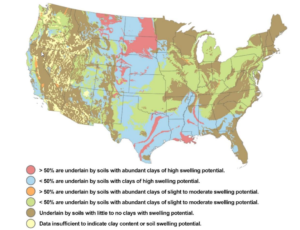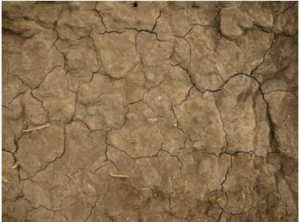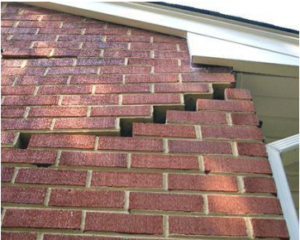Did you know that some soils act like a sponge? The more water certain types of soils absorb, the more those soils increase in volume (size). There are many terms that refer to these types of soil: expansive
soils, expandable soils, expandable clay, shrink-swell soils (say that three times fast!).

Whatever name is applied, expansive soils are ubiquitous across North America and cause billions of dollars in damage annually. The American Society of Civil Engineers (ASCE) estimates that half of all homes in the US are built on expansive soils, and half of those homes will experience some level of expansive soil damage. The ASCE also claims that expansive soils account for more home-related damage each year than floods, tornadoes, and hurricanes combined!
Expansive soils cause enormous amounts of damage, but surprisingly most people have never heard of the phenomenon. In many cases, damage from expansive soils is attributed to poor construction practices or a misconception that all buildings experience some type of “settlement” as they age.
What are Expansive Soils?
Expansive soils contain minerals that are capable of absorbing water. When the minerals absorb water, the soil increases in volume; expansion of 10% is not uncommon. Changes in the soil’s volume exert substantial force on a building’s structure and can cause significant damage.

“Expansive” also is somewhat of a misnomer because potential problems don’t just occur when the soil expands from water absorption – when expansive soils become too dry, they also contract. And as soil shrinks from around a foundation, the structure settles, footings drop, and framing shifts. The evidence of settlement is visible via cracks in drywall and concrete, in doors and windows that aren’t level, and in damage and separations that occur at exterior siding.
Soil Detectives: Tell-Tale Clues
Inspectors and engineers examine structures carefully when they suspect that expansive soils are quietly working their mayhem. Some common clues that indicate expansive soils are present include:
 Cracks at the interior corners of windows and doors or misalignment which makes the windows or doors difficult to open and close.
Cracks at the interior corners of windows and doors or misalignment which makes the windows or doors difficult to open and close.- Cracks or spread caulk joints between siding and trim, at the corners of the structure, or around the fascia and soffit areas.
- Cracks in concrete driveways, walks and slabs which occur as they heave and sink based on soil conditions (moisture).
Homes with rigid, masonry siding, such as brick and stucco, show evidence of settlement more readily than homes with more forgiving finishes such as vinyl and wood lap, which are more likely to flex with the soil’s movement.
Unfortunate and Expensive Consequences
Unfortunately, “expansive” can often lead directly to “expensive.” The magnitude of damages to structures can be extensive, impair the usefulness of the structure, and detract aesthetically from the home. Maintenance and repair requirements can be exhausting emotionally and financially and, in some extreme cases, expenses can grossly exceed the original cost of the foundation.
Lateral forces exerted by expanding soils can lead to the inward buckling of basement walls, a primary reason many homes in areas with prevalent expansive soils are built with slab-on-grade foundations without basements or crawl spaces.
Minimizing Damage: Control Moisture
Structural damage from expansive soils often can be minimized or avoided altogether by minimizing fluctuations in soil water content around the foundation:
- In areas that are consistently moist, soil should be watered during extended dry periods to maintain a consistent moisture condition.
- Conversely, in typically arid regions, moisture and landscaping should be maintained several feet away from the structure’s foundation.
- Surface drainage and downspout outlets should be maintained a minimum of three feet from the foundation and sprinklers should be positioned away from the home.
- Because tree roots withdraw water from soils, which could cause drying and cracking, trees should be planted no closer than 15 feet from foundations but a distance of greater than 25 feet is optimal.
- Plumbing drain lines and supply lines should be tested on a regular basis to make sure that there are no leaks under the slab or foundation.
What Actions Should You Take?
If cracks in the interior or exterior of the home are discovered during a property assessment, consider the following actions:
- Retain a structural engineer to conduct a more extensive evaluation to determine if the structure is actively moving or has experienced foundation failure.
- Inquire as to whether previous foundation repairs, such as the installation of stabilizing piers, have been performed to determine if a warranty is present. If stabilizing piers are present, the foundation company may take measurements of the slab and compare them to the measurements taken before piers were installed to determine if additional repairs are necessary.
- Carefully consider your clients’ risk tolerance, internal policies and resale considerations
